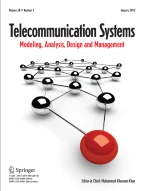Abstract
The stationarity test of long-range dependent (LRD) traffic remains a challenge problem in the field of traffic engineering. Due to the importance of traffic theory in the Internet, to find a solution to that problem is greatly desired. This paper presents a method of the weak stationarity test of a single history LRD traffic series of finite length. How to apply this method to testing the stationarity of real traffic is demonstrated. The results in this paper suggest that there may be no general conclusion that traffic is either stationary or non-stationary since the stationarity of traffic is observation-scale dependent. Some of the investigated real-traffic traces that are stationary in an observation scale may be non-stationary in a larger observation scale.
Similar content being viewed by others
Explore related subjects
Discover the latest articles, news and stories from top researchers in related subjects.References
Papoulis, A. (1984). Probability, random variables, and stochastic processes. New York: McGraw-Hill.
Priestley, M. B. (1965). Evolutionary spectra and non-stationary processes. Journal of the Royal Statistical Society: Series B, 27(2), 204–237.
Al-Shoshan, A. I. (1999). Time-varying modeling of a nonstationary signal. Telecommunication Systems, 12(4), 389–396.
Bendat, J. S., & Piersol, A. G. (2000). Random data: analysis and measurement procedure (3rd ed.). New York: Wiley.
Von Sachs, R., & Neumann, M. H. (2000). A wavelet-based test for stationarity. Journal of Time Series Analysis, 21(5), 597–613.
Ling, S. (2004). Estimation and testing stationarity for double-autoregressive models. Journal of the Royal Statistical Society: Series B, 66(1), 63–78.
Psaradakis, Z. (2006). Blockwise bootstrap testing for stationarity. Statistics & Probability Letters, 76(6), 562–570.
Rodrigues, P. M. M., & Rubia, A. (2008). A note on testing for nonstationarity in autoregressive processes with level dependent conditional heteroskedasticity. Statistical Papers, 49(3), 581–593.
Borgnat, P., & Flandrin, P. (2009). Stationarization via surrogates. Journal of Statistical Mechanics: Theory and Experiment, 29, 1–14.
Tsybakov, B., & Georganas, N. D. (1998). Self-similar processes in communications networks. IEEE Transactions on Information Theory, 44(5), 1713–1725.
Nogueira, A., Salvador, P., Valadas, R., & Pacheco, A. (2003). Modeling network traffic with multifractal behavior. Telecommunication Systems, 24(2–3), 339–362.
Li, M. (2007). Modeling autocorrelation functions of long-range dependent teletraffic series based on optimal approximation in Hilbert space-a further study. Applied Mathematical Modelling, 31(3), 625–631.
Leland, W. E., Taqqu, M. S., Willinger, W., & Wilson, D. V. (1994). On the self-similar nature of Ethernet traffic (extended version). IEEE/ACM Transactions on Networking, 2(1), 1–15.
Paxson, V., & Floyd, S. (1995). Wide area traffic: the failure of Poisson modeling. IEEE/ACM Transactions on Networking, 3(3), 226–244.
Beran, J. (1994). Statistics for long-memory processes. London: Chapman & Hall.
Jin, X., & Min, G. (2008). Performance modelling of generalized processor sharing systems with multiple self-similar traffic flows. Telecommunication Systems, 38(3–4), 111–120.
Mandelbrot, B. B. (1976). Note on the definition and the stationarity of fractional Gaussian noise. Journal of Hydrology, 30(4), 407–409.
Vaton, S. (1998). A new test of stationarity and its application to teletraffic data. In ICASSP’98: Vol. 6. Proceedings of the 1998 IEEE international conference on acoustics, speech and signal processing (pp. 3449–3452). Seattle.
Abry, P., & Veitch, D. (1998). Wavelet analysis of long-range dependent traffic. IEEE Transactions on Information Theory, 44(1), 2–15.
Zhang, Y., Paxson, V., & Shenker, S. (2000). The stationarity of Internet path properties: routing, loss, and throughput (ACIRI Technical Report). May 2000.
Li, M., Zhang, Y.-Y., & Zhao, W. (2007). A practical method for weak stationarity test of network traffic with long-range dependence. International Journal of Mathematics and Computers in Simulation, 1(4), 307–311.
Heyman, D. P., & Lakshman, T. V. (1999). On the relevance of long-range dependence in network traffic. IEEE/ACM Transactions on Networking, 7(5), 629–640.
Liu, C., Wiel, S. V., & Yang, J. (2003). A nonstationary traffic train model for fine scale inference from coarse scale counts. IEEE Journal on Selected Areas in Communications, 21(6), 895–907.
Rincón, D., & Sallent, S. (2005). In LNCS : Vol. 3375. On-line segmentation of non-stationary fractal network traffic with wavelet transforms and log-likelihood-based statistics (pp. 110–123). Berlin: Springer.
Mitra, S. K., & Kaiser, J. F. (Eds.) (1993). Handbook for digital signal processing. New York: Wiley.
Fu, K. S. (Ed.) (1976). Digital pattern recognition. Berlin: Springer.
Li, M. (2005). An iteration method to adjusting random loading for a laboratory fatigue test. International Journal of Fatigue, 27(7), 783–789.
Author information
Authors and Affiliations
Corresponding author
Rights and permissions
About this article
Cite this article
Li, M., Chen, WS. & Han, L. Correlation matching method for the weak stationarity test of LRD traffic. Telecommun Syst 43, 181–195 (2010). https://doi.org/10.1007/s11235-009-9206-5
Published:
Issue Date:
DOI: https://doi.org/10.1007/s11235-009-9206-5
